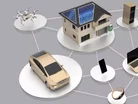The Internet of Things is the Land of Opportunity

By Neil Cameron, General Manager, Johnson Controls Building Efficiency.
Stay Connected! Follow @AfricaBizReview and @MrNLon on Twitter. Like our Facebook Page.
The worldwide web most of us are familiar with is a place populated by about 2.5 billion people who go online to find information, entertainment and shopping, or to stay in touch with friends and share ideas with colleagues. The internet was made by people, for people.
But now it has become the Internet of Things (IoT). Experts predict that in a few years there could be 100 billion devices—actual physical things—connected to the web. Some of these devices are online today and more, many more, are coming soon.
RELATED: Systems of Things: The Building Blocks for the Next Internet Revolution
In the IoT, devices equipped with sensors, hardware and software are networked together through the internet, where they can communicate with one another, machine-to-machine (M2M). Intelligent devices are changing the way we eat, drive, communicate, receive medical care, light our cities and consume energy.
Sensors embedded in roads control traffic flow. Vending machines tell us when they need to be refilled. A heart patient’s pacemaker alerts her cardiologist to a problem before it becomes dangerous. With sensors in the soil, farm fields know when they need to be irrigated and fertilised.
Nowhere is the impact of the IoT felt more than in the world of building efficiency. The big game-changer is M2M communication, coupled with sophisticated new tools like cloud-based solutions and applications, which analyse the massive amounts data gathered by sensors and turn it into useful information that helps building managers do their jobs better. Imagine thousands of electrical switches, thermostats, lights, door locks, air-handling units, chillers and other components gathering and sharing data. Even solving problems on their own.
We are seeing this more acutely in the South African market where buildings aggregate information or data from sensors but there isn’t a significant uptake to ‘share’ this information over the ‘Internet’, ultimately underpinning smart environments that lead to smart cities. However, value is certainly being derived with real-time communication and access to data which delivers a number of benefits such as proactive monitoring of the facility and the early detection of failure which can significantly reduce downtime.
In the very near future, lights equipped with sensors that detect the presence or absence of building occupants will cut energy consumption by an estimated 50 to 75 percent. Interconnected units of equipment will work together to find the most efficient way to heat or cool a facility without human intervention. Machines will diagnose their own need for maintenance, which will be scheduled automatically. Total integration will become a reality.
This is all happening now because two important drivers are in place: Opportunity and necessity.
Advances in wireless networking technology and standardised communication protocols make it possible to collect data from sensors almost anywhere, any time. Silicon chips continue to get smaller and more powerful even as their cost drops. Advancements like cloud computing make it possible to crunch numbers and store data on a never-before-seen scale, again with declining costs.
RELATED: [Survey] What the Internet of Things means to South Africans
And there are real needs. As the global demand for energy rises, sustainability and energy efficiency aren’t just good financial goals —they’re becoming mandates in many countries, creating new and very real business challenges.
The IoT gives us the power to meet these challenges, and the opportunity to redefine absolutely every aspect of our industry. Because when everything works together, everything works better, works more efficiently and lasts longer than ever before. And it doesn’t stop with making buildings more efficient. Because the IoT makes us humans work better and more efficiently, too.
Featured Articles
SAP has announced it has appointed a new President for a newly-created EMEA region, aiming to make the most of the opportunities of cloud and AI technology
Technology giant SAP has expanded its portfolio with the acquisition of LeanIX, a leader in enterprise architecture management (EAM) software
To help businesses achieve increased productivity, Siemens and Microsoft are deepening their partnership by showcasing the benefits of generative AI



